高三英语阅读课教案2
- 格式:doc
- 大小:40.00 KB
- 文档页数:4
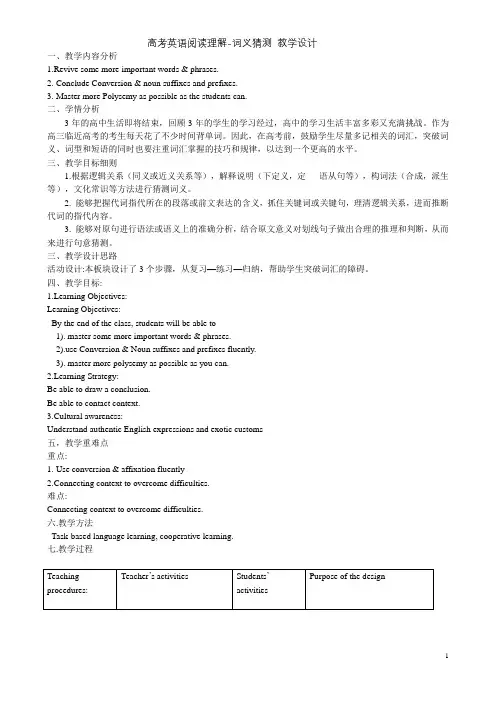
高考英语阅读理解-词义猜测教学设计一、教学内容分析1.Revive some more important words & phrases.2. Conclude Conversion & noun suffixes and prefixes.3. Master more Polysemy as possible as the students can.二、学情分析3年的高中生活即将结束,回顾3年的学生的学习经过,高中的学习生活丰富多彩又充满挑战。
作为高三临近高考的考生每天花了不少时间背单词。
因此,在高考前,鼓励学生尽量多记相关的词汇,突破词义、词型和短语的同时也要注重词汇掌握的技巧和规律,以达到一个更高的水平。
三、教学目标细则1.根据逻辑关系(同义或近义关系等),解释说明(下定义,定语从句等),构词法(合成,派生等),文化常识等方法进行猜测词义。
2. 能够把握代词指代所在的段落或前文表达的含义,抓住关键词或关键句,理清逻辑关系,进而推断代词的指代内容。
3. 能够对原句进行语法或语义上的准确分析,结合原文意义对划线句子做出合理的推理和判断,从而来进行句意猜测。
三、教学设计思路活动设计:本板块设计了3个步骤,从复习—练习—归纳,帮助学生突破词汇的障碍。
四、教学目标:1.Learning Objectives:Learning Objectives:By the end of the class, students will be able to1). master some more important words & phrases.2).use Conversion & Noun suffixes and prefixes fluently.3). master more polysemy as possible as you can.2.Learning Strategy:Be able to draw a conclusion.Be able to contact context.3.Cultural awareness:Understand authentic English expressions and exotic customs五,教学重难点重点:1. Use conversion & affixation fluently2.Connecting context to overcome difficulties.难点:Connecting context to overcome difficulties.六.教学方法Task-based language learning, cooperative learning.七.教学过程高考阅读---词义猜测2023泉州三模CAnother study by the Think Wood campaign concludes that nature can have a beneficial effect on creativity, concentration and well-being. Not only do cool-looking biophilic offices help companies recruit(招聘) talent in an incredibly tight labor market, but they also nudge the new talent to perform better at work.(2023泉州三模)33. What does the underlined word “nudge”in paragraph 4 mean?A. Encourage.B. Anticipate.C. Remind.D. Promise2023广东二模 CClare says the concept has been used for years in different ways. Scientists sample pathogens(病原体) from the air, which has been used to help track COVID-19. Environmental DNA can also be collected from water to help ease invasive species.33. What does the underlined phrase “the concept”in paragraph 3 refer to?A. Detecting danger in the air.B. Protecting endangered animals.C. Sucking DNA out of the air.D. Collecting environmental samples.CYesterday, after a day of Zoom (视频会议软件) meetings in my living room, I stepped out for a walk, leaving my teen son bored on the couch. Bleecker Street, usually packed with people, was sprinkled with only the occasional pedestrians. Bars and restaurants lining the street were dark. Stores with bright neon lights, doors open, beckoned for the rare passers-by to enter. After just a week of the Covid-19 pandemic, an afternoon walk in Greenwich Village neighborhood felt surreal.But then I noticed a row of daffodils (水仙) reaching for the sun in the small triangle-shaped park by Minetta Lane. On the windows of a locked restaurant, in bright yellow paint, were the words “We love you, West Village. Take care of each other." My phone buzzed—a colleague, sent a picture of her newborn baby just home from the hospital. I arrived home to find my son animated on the couch playing a video game virtually with his friends. Life, love, play, and human connection persist, even though our world has been turned upside down.In my welcome note to the new students in the Fall, I wrote that this year is about ourcollege's core values of inclusion, innovation, and impact and emphasized the power of interconnection. Today,these core values persist, with interconnection taking on even greater significance. Our collaborative spirit has always given us an advantage-academically, creatively, culturally, and now, remotely.A wise person once told me that getting through a crisis is like being given a new hand of cards in the middle of a game. We are halfway through the semester, with new hands to play, but the game hasn't changed. We will find new ways to continue to work, teach, create, and learn. Let's also continue the informal interactions that make us a community-the study groups,coffee dates, drop-ins just to say hello. In doing so, we will remain connected.We will come together, from spaces around the world, to meet this new reality. This is who we are. Nothing not space,nor time can keep us from moving forward, together.28.What can he inferred from paragraph 1?A.The Covid-19 pandemic is unstoppable.B.The effects of the pandemic could he easily felt.C.Nothing is the same except that the business goes slow as usual.D.People have every reason to be worried about the future.29.What does the writer include in paragraph 2?A.Daily routines that seemed insignificant.B.Reminders that the world has been changed.C.Events that people can do during the pandemic.D.Things or people that carry symbolic meanings.30.What does the underlined word "collaborative" mean in paragraph 3?A.Cooperative.B.Pioneering.C.Independent.D.Adventurous.31..What is the main purpose of the text?A.To express wisdom gained from previous experience.B.To give people some tips on how to handle a crisis.C.To deliver an uplifting message over the pandemic.D.To encourage people to enjoy the great outdoors.。
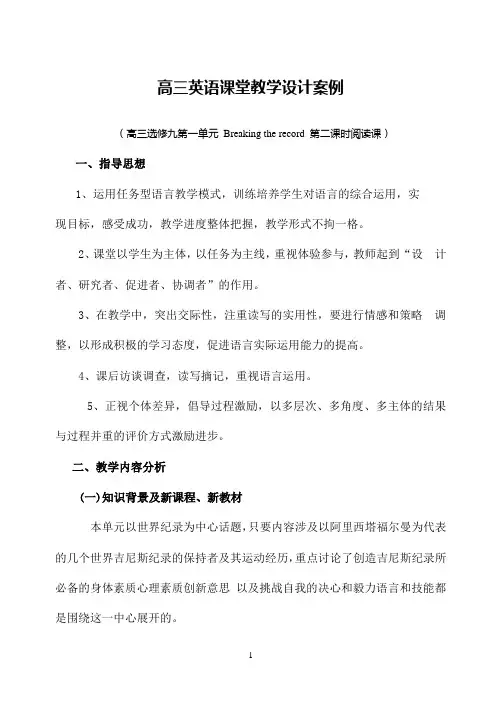
高三英语课堂教学设计案例(高三选修九第一单元Breaking the record 第二课时阅读课)一、指导思想1、运用任务型语言教学模式,训练培养学生对语言的综合运用,实现目标,感受成功,教学进度整体把握,教学形式不拘一格。
2、课堂以学生为主体,以任务为主线,重视体验参与,教师起到“设计者、研究者、促进者、协调者”的作用。
3、在教学中,突出交际性,注重读写的实用性,要进行情感和策略调整,以形成积极的学习态度,促进语言实际运用能力的提高。
4、课后访谈调查,读写摘记,重视语言运用。
5、正视个体差异,倡导过程激励,以多层次、多角度、多主体的结果与过程并重的评价方式激励进步。
二、教学内容分析(一)知识背景及新课程、新教材本单元以世界纪录为中心话题,只要内容涉及以阿里西塔福尔曼为代表的几个世界吉尼斯纪录的保持者及其运动经历,重点讨论了创造吉尼斯纪录所必备的身体素质心理素质创新意思以及挑战自我的决心和毅力语言和技能都是围绕这一中心展开的。
本课是是本单元第二课——“阅读课”,于是本单元的重点。
文章的主题是“路永在前方”其内容介绍了世界吉尼斯的保持者阿西里塔福尔曼,他不是职业运动员,但其运动成就让许多运动员望尘莫及,本课通过阿里西塔福尔曼的成长经历以及获得这些成就的精神动力激励学生认识自我的潜力找到精神动力的源泉,实现梦想。
(二)教学重点难点(1)重点:1.了解记叙文的文体特点并以此指导阅读;训练skimming, scanning, careful reading等阅读微技能;3.对文章深层次的理解及细节的欣赏,认识及分析主人公的人物特征及人物性格。
(2)难点: 1。
阅读技能的训练;2.对记叙文的鉴赏能力及人物评价。
(确立依据:阅读在整个英语教育体系和高考中都占有重要比例,阅读能力的提高不是一朝一夕事。
再高明的老师也不可能把自己的阅读能力传授给学生。
学生阅读能力的提高只能在老师的指导下通过实践训练获得。
复述课文是检查学生对课文的理解程度,同时又是提高学生口语能力的重要方法)三、学情分析一方面,高中年龄段的学生对周围的事物较为敏感,有自己的观点和看法,他们不满足于教科书上的知识,想获得更多的信息。
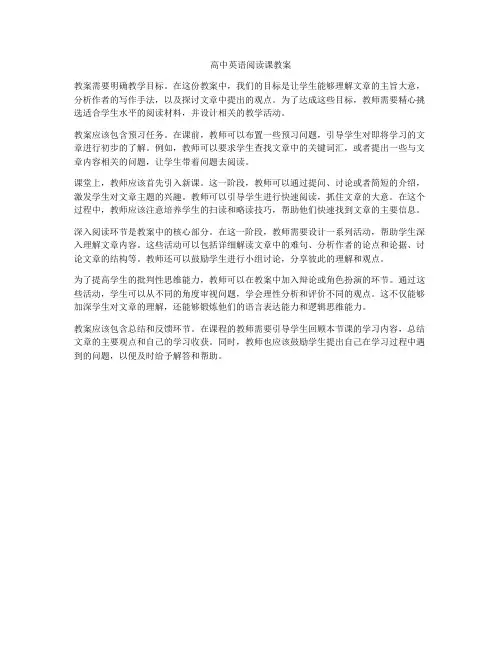
高中英语阅读课教案
教案需要明确教学目标。
在这份教案中,我们的目标是让学生能够理解文章的主旨大意,分析作者的写作手法,以及探讨文章中提出的观点。
为了达成这些目标,教师需要精心挑选适合学生水平的阅读材料,并设计相关的教学活动。
教案应该包含预习任务。
在课前,教师可以布置一些预习问题,引导学生对即将学习的文章进行初步的了解。
例如,教师可以要求学生查找文章中的关键词汇,或者提出一些与文章内容相关的问题,让学生带着问题去阅读。
课堂上,教师应该首先引入新课。
这一阶段,教师可以通过提问、讨论或者简短的介绍,激发学生对文章主题的兴趣。
教师可以引导学生进行快速阅读,抓住文章的大意。
在这个过程中,教师应该注意培养学生的扫读和略读技巧,帮助他们快速找到文章的主要信息。
深入阅读环节是教案中的核心部分。
在这一阶段,教师需要设计一系列活动,帮助学生深入理解文章内容。
这些活动可以包括详细解读文章中的难句、分析作者的论点和论据、讨论文章的结构等。
教师还可以鼓励学生进行小组讨论,分享彼此的理解和观点。
为了提高学生的批判性思维能力,教师可以在教案中加入辩论或角色扮演的环节。
通过这些活动,学生可以从不同的角度审视问题,学会理性分析和评价不同的观点。
这不仅能够加深学生对文章的理解,还能够锻炼他们的语言表达能力和逻辑思维能力。
教案应该包含总结和反馈环节。
在课程的教师需要引导学生回顾本节课的学习内容,总结文章的主要观点和自己的学习收获。
同时,教师也应该鼓励学生提出自己在学习过程中遇到的问题,以便及时给予解答和帮助。
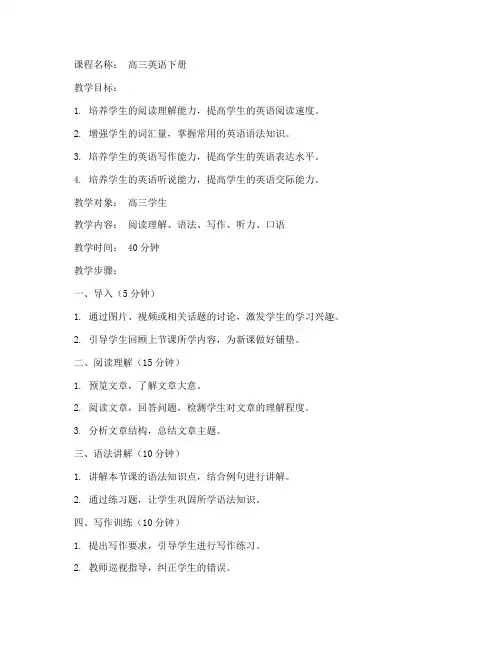
课程名称:高三英语下册教学目标:1. 培养学生的阅读理解能力,提高学生的英语阅读速度。
2. 增强学生的词汇量,掌握常用的英语语法知识。
3. 培养学生的英语写作能力,提高学生的英语表达水平。
4. 培养学生的英语听说能力,提高学生的英语交际能力。
教学对象:高三学生教学内容:阅读理解、语法、写作、听力、口语教学时间: 40分钟教学步骤:一、导入(5分钟)1. 通过图片、视频或相关话题的讨论,激发学生的学习兴趣。
2. 引导学生回顾上节课所学内容,为新课做好铺垫。
二、阅读理解(15分钟)1. 预览文章,了解文章大意。
2. 阅读文章,回答问题,检测学生对文章的理解程度。
3. 分析文章结构,总结文章主题。
三、语法讲解(10分钟)1. 讲解本节课的语法知识点,结合例句进行讲解。
2. 通过练习题,让学生巩固所学语法知识。
四、写作训练(10分钟)1. 提出写作要求,引导学生进行写作练习。
2. 教师巡视指导,纠正学生的错误。
五、听力训练(5分钟)1. 播放听力材料,让学生完成听力任务。
2. 解答听力问题,总结听力技巧。
六、口语训练(5分钟)1. 设置口语情景,让学生进行口语表达。
2. 教师点评,鼓励学生积极参与。
七、总结与反馈(5分钟)1. 总结本节课所学内容,强调重点和难点。
2. 鼓励学生在课后进行复习和巩固。
教学资源:1. 教材:人教版高中英语下册2. 辅助资料:阅读理解练习题、语法练习题、写作范文、听力材料、口语情景模拟教学评价:1. 课堂参与度:观察学生在课堂上的发言情况,评价学生的积极性。
2. 知识掌握程度:通过课堂提问、练习题等方式,检测学生对知识的掌握情况。
3. 写作能力:评价学生的写作水平,包括语法、词汇、表达等方面。
4. 听力与口语能力:通过听力练习和口语情景模拟,评价学生的听说能力。
教学反思:1. 课堂氛围是否活跃,学生是否积极参与。
2. 教学方法是否得当,是否能够激发学生的学习兴趣。
3. 教学内容是否充实,是否能够满足学生的学习需求。
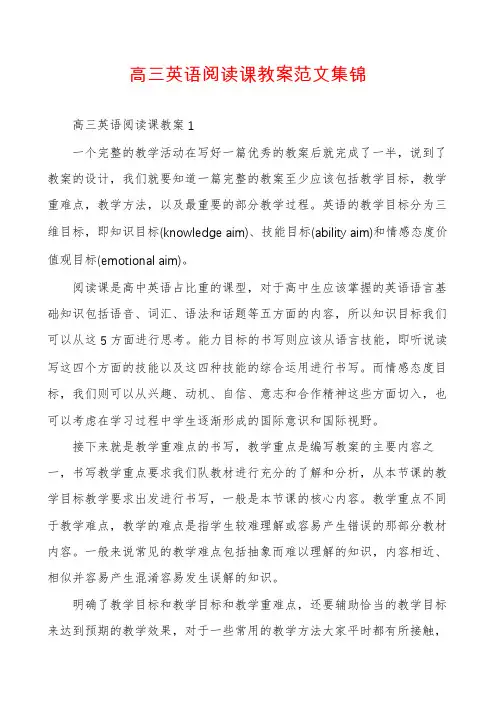
高三英语阅读课教案范文集锦高三英语阅读课教案1一个完整的教学活动在写好一篇优秀的教案后就完成了一半,说到了教案的设计,我们就要知道一篇完整的教案至少应该包括教学目标,教学重难点,教学方法,以及最重要的部分教学过程。
英语的教学目标分为三维目标,即知识目标(knowledge aim)、技能目标(ability aim)和情感态度价值观目标(emotional aim)。
阅读课是高中英语占比重的课型,对于高中生应该掌握的英语语言基础知识包括语音、词汇、语法和话题等五方面的内容,所以知识目标我们可以从这5方面进行思考。
能力目标的书写则应该从语言技能,即听说读写这四个方面的技能以及这四种技能的综合运用进行书写。
而情感态度目标,我们则可以从兴趣、动机、自信、意志和合作精神这些方面切入,也可以考虑在学习过程中学生逐渐形成的国际意识和国际视野。
接下来就是教学重难点的书写,教学重点是编写教案的主要内容之一,书写教学重点要求我们队教材进行充分的了解和分析,从本节课的教学目标教学要求出发进行书写,一般是本节课的核心内容。
教学重点不同于教学难点,教学的难点是指学生较难理解或容易产生错误的那部分教材内容。
一般来说常见的教学难点包括抽象而难以理解的知识,内容相近、相似并容易产生混淆容易发生误解的知识。
明确了教学目标和教学目标和教学重难点,还要辅助恰当的教学目标来达到预期的教学效果,对于一些常用的教学方法大家平时都有所接触,这里就不再详细的介绍,但是要告诉大家,教学方法的选择要注意全面、综合的考虑教学目标、教学任务、教学内容。
学生的水平以及自身的教学特点。
教师的教学艺术在很大的程度上取决于其教学方法运用的是否合适、得当。
因此早选择教学方法时要与自己的教学实际相统一。
在教学目标,重难点,教学方法逐一完成以后就进入到了教案设计的重头戏,教学过程的设计,我们来突出讲解一些在高中英语中占比例比较大的课型,阅读课。
在设计教学过程时有很多可操作的方法,但是对于高中英语而言,更好我们把控的一种设计方法就是按照PWP的形式进行书写。
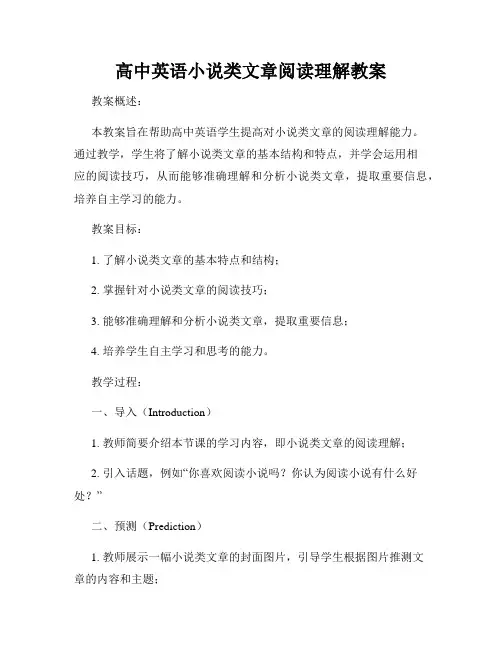
高中英语小说类文章阅读理解教案教案概述:本教案旨在帮助高中英语学生提高对小说类文章的阅读理解能力。
通过教学,学生将了解小说类文章的基本结构和特点,并学会运用相应的阅读技巧,从而能够准确理解和分析小说类文章,提取重要信息,培养自主学习的能力。
教案目标:1. 了解小说类文章的基本特点和结构;2. 掌握针对小说类文章的阅读技巧;3. 能够准确理解和分析小说类文章,提取重要信息;4. 培养学生自主学习和思考的能力。
教学过程:一、导入(Introduction)1. 教师简要介绍本节课的学习内容,即小说类文章的阅读理解;2. 引入话题,例如“你喜欢阅读小说吗?你认为阅读小说有什么好处?”二、预测(Prediction)1. 教师展示一幅小说类文章的封面图片,引导学生根据图片推测文章的内容和主题;2. 学生以小组为单位进行讨论,提出各自的预测,并与其他小组分享。
三、阅读指导(Reading Guidance)1. 教师引导学生了解小说类文章的基本结构,包括开头、主体和结尾;2. 学生分析已学过的小说类文章,掌握其常用的叙事方式和描写手法;3. 教师指导学生在阅读时注意关键词和重要细节,帮助理解整个故事情节。
四、阅读理解(Reading Comprehension)1. 学生独立阅读一篇小说类文章;2. 学生回答与文章内容相关的问题,包括主旨、人物、情节等方面;3. 学生将回答的问题进行整理,形成文章摘要或概括。
五、讨论与交流(Discussion and Communication)1. 学生以小组为单位进行讨论,互相交流自己对文章的理解和摘要;2. 每个小组派出一名代表进行汇报,分享各组的讨论成果。
六、总结与拓展(Summary and Extension)1. 教师对本节课的学习内容进行总结,强调小说类文章的阅读技巧;2. 教师提供更多小说类文章的阅读材料,供学生课后拓展阅读。
教学反思:通过本节课的教学,学生不仅了解了小说类文章的基本结构和特点,还学会了阅读技巧,增强了对小说类文章的阅读理解能力。
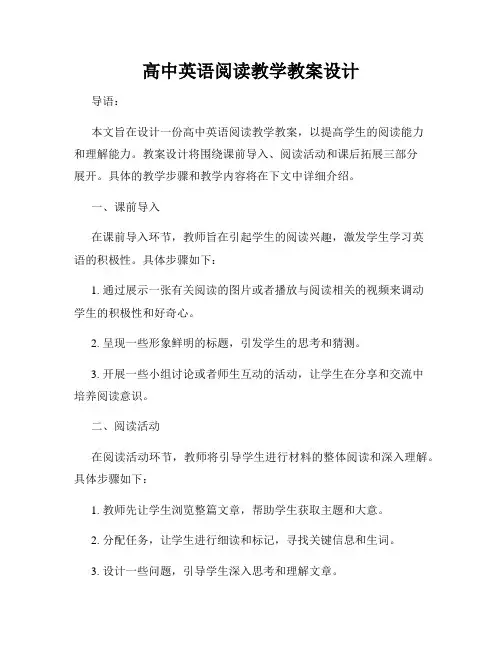
高中英语阅读教学教案设计导语:本文旨在设计一份高中英语阅读教学教案,以提高学生的阅读能力和理解能力。
教案设计将围绕课前导入、阅读活动和课后拓展三部分展开。
具体的教学步骤和教学内容将在下文中详细介绍。
一、课前导入在课前导入环节,教师旨在引起学生的阅读兴趣,激发学生学习英语的积极性。
具体步骤如下:1. 通过展示一张有关阅读的图片或者播放与阅读相关的视频来调动学生的积极性和好奇心。
2. 呈现一些形象鲜明的标题,引发学生的思考和猜测。
3. 开展一些小组讨论或者师生互动的活动,让学生在分享和交流中培养阅读意识。
二、阅读活动在阅读活动环节,教师将引导学生进行材料的整体阅读和深入理解。
具体步骤如下:1. 教师先让学生浏览整篇文章,帮助学生获取主题和大意。
2. 分配任务,让学生进行细读和标记,寻找关键信息和生词。
3. 设计一些问题,引导学生深入思考和理解文章。
4. 帮助学生掌握阅读策略,如扫读、略读和精读。
5. 引导学生进行词汇和语法的分析,培养学生的语言运用能力。
三、课后拓展在课后拓展环节,教师将组织学生进行一些拓展活动,以促进学生在阅读中的自主学习和思考。
具体步骤如下:1. 布置一些与文章内容相关的作业,如写一篇小短文、设计一个续写、形成自己的问题等,以检验学生对文章的理解和运用能力。
2. 推荐一些相关的阅读材料,鼓励学生拓宽阅读视野。
3. 鼓励学生与同学分享自己的阅读心得和体会,培养合作学习的氛围。
结语:通过本节课的阅读教学活动,学生应该能够提高他们的阅读能力和理解能力,同时也能培养他们的自主学习和合作学习的能力。
希望通过本教案设计,能够为高中英语阅读教学提供一种有效的教学参考。
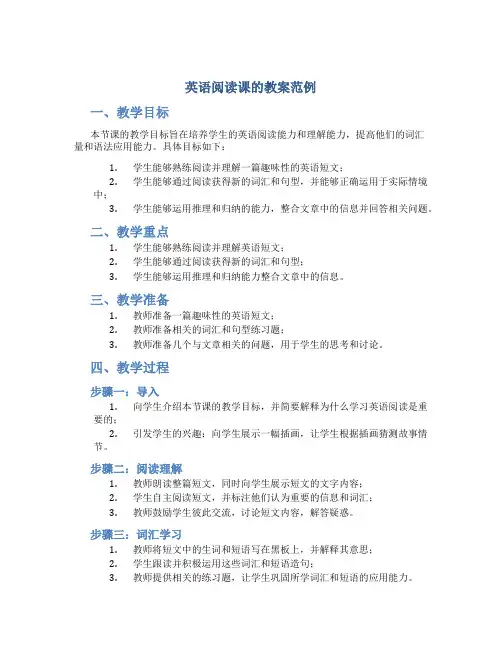
英语阅读课的教案范例一、教学目标本节课的教学目标旨在培养学生的英语阅读能力和理解能力,提高他们的词汇量和语法应用能力。
具体目标如下:1.学生能够熟练阅读并理解一篇趣味性的英语短文;2.学生能够通过阅读获得新的词汇和句型,并能够正确运用于实际情境中;3.学生能够运用推理和归纳的能力,整合文章中的信息并回答相关问题。
二、教学重点1.学生能够熟练阅读并理解英语短文;2.学生能够通过阅读获得新的词汇和句型;3.学生能够运用推理和归纳能力整合文章中的信息。
三、教学准备1.教师准备一篇趣味性的英语短文;2.教师准备相关的词汇和句型练习题;3.教师准备几个与文章相关的问题,用于学生的思考和讨论。
四、教学过程步骤一:导入1.向学生介绍本节课的教学目标,并简要解释为什么学习英语阅读是重要的;2.引发学生的兴趣:向学生展示一幅插画,让学生根据插画猜测故事情节。
步骤二:阅读理解1.教师朗读整篇短文,同时向学生展示短文的文字内容;2.学生自主阅读短文,并标注他们认为重要的信息和词汇;3.教师鼓励学生彼此交流,讨论短文内容,解答疑惑。
步骤三:词汇学习1.教师将短文中的生词和短语写在黑板上,并解释其意思;2.学生跟读并积极运用这些词汇和短语造句;3.教师提供相关的练习题,让学生巩固所学词汇和短语的应用能力。
步骤四:再阅读和思考1.学生再次阅读短文,尝试回答教师提出的问题;2.学生可自行思考和整理答案,也可与同学进行群体讨论;3.教师引导学生思考文章中的逻辑关系和引导词语的作用。
步骤五:总结和讨论1.教师与学生一起总结本节课的学习内容和所获得的收获;2.学生可以提出问题和分享自己的思考。
五、课后作业1.学生完成相关的词汇和句型习题;2.学生根据短文内容写一篇简短的读后感,并分享给同学。
六、教学反思本节课通过引导学生阅读一篇趣味性的英语短文,培养了他们的阅读能力和理解能力。
通过词汇学习和思考问题,学生不仅可以掌握新的词汇和句型,还可以锻炼他们的推理和归纳能力。
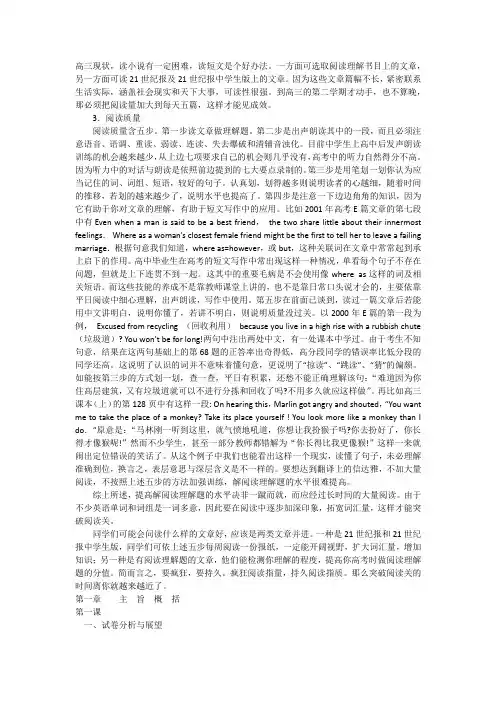
高三现状,读小说有一定困难,读短文是个好办法。
一方面可选取阅读理解书目上的文章,另一方面可读21世纪报及21世纪报中学生版上的文章。
因为这些文章篇幅不长,紧密联系生活实际,涵盖社会现实和天下大事,可读性很强。
到高三的第二学期才动手,也不算晚,那必须把阅读量加大到每天五篇,这样才能见成效。
3.阅读质量阅读质量含五步。
第一步读文章做理解题。
第二步是出声朗读其中的一段,而且必须注意语音、语调、重读、弱读、连读、失去爆破和清辅音浊化。
目前中学生上高中后发声朗读训练的机会越来越少,从上边七项要求自己的机会则几乎没有,高考中的听力自然得分不高。
因为听力中的对话与朗读是依照前边提到的七大要点录制的。
第三步是用笔划一划你认为应当记住的词、词组、短语,较好的句子。
认真划,划得越多则说明读者的心越细,随着时间的推移,若划的越来越少了,说明水平也提高了。
第四步是注意一下边边角角的知识,因为它有助于你对文章的理解,有助于短文写作中的应用。
比如2001年高考E篇文章的第七段中有Even when a man is said to be a best friend,the two share little about their innermost feelings.Where as a woman’s closest female friend might be the first to tell her to leave a failing marriage.根据句意我们知道,where as=however,或but,这种关联词在文章中常常起到承上启下的作用。
高中毕业生在高考的短文写作中常出现这样一种情况,单看每个句子不存在问题,但就是上下连贯不到一起。
这其中的重要毛病是不会使用像where as这样的词及相关短语。
而这些技能的养成不是靠教师课堂上讲的,也不是靠日常口头说才会的,主要依靠平日阅读中细心理解,出声朗读,写作中使用。
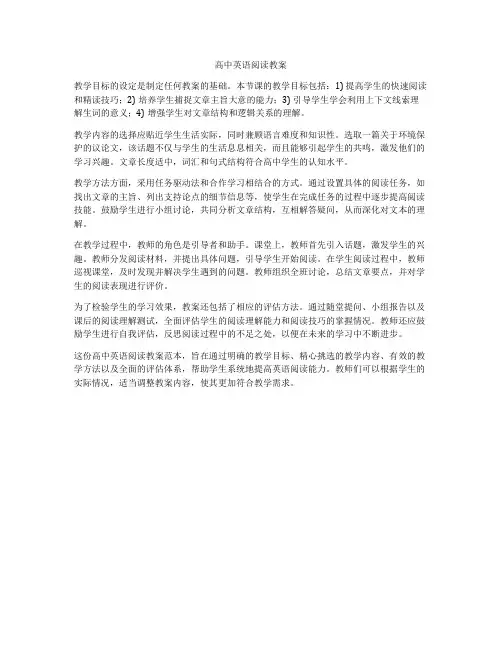
高中英语阅读教案教学目标的设定是制定任何教案的基础。
本节课的教学目标包括:1) 提高学生的快速阅读和精读技巧;2) 培养学生捕捉文章主旨大意的能力;3) 引导学生学会利用上下文线索理解生词的意义;4) 增强学生对文章结构和逻辑关系的理解。
教学内容的选择应贴近学生生活实际,同时兼顾语言难度和知识性。
选取一篇关于环境保护的议论文,该话题不仅与学生的生活息息相关,而且能够引起学生的共鸣,激发他们的学习兴趣。
文章长度适中,词汇和句式结构符合高中学生的认知水平。
教学方法方面,采用任务驱动法和合作学习相结合的方式。
通过设置具体的阅读任务,如找出文章的主旨、列出支持论点的细节信息等,使学生在完成任务的过程中逐步提高阅读技能。
鼓励学生进行小组讨论,共同分析文章结构,互相解答疑问,从而深化对文本的理解。
在教学过程中,教师的角色是引导者和助手。
课堂上,教师首先引入话题,激发学生的兴趣。
教师分发阅读材料,并提出具体问题,引导学生开始阅读。
在学生阅读过程中,教师巡视课堂,及时发现并解决学生遇到的问题。
教师组织全班讨论,总结文章要点,并对学生的阅读表现进行评价。
为了检验学生的学习效果,教案还包括了相应的评估方法。
通过随堂提问、小组报告以及课后的阅读理解测试,全面评估学生的阅读理解能力和阅读技巧的掌握情况。
教师还应鼓励学生进行自我评估,反思阅读过程中的不足之处,以便在未来的学习中不断进步。
这份高中英语阅读教案范本,旨在通过明确的教学目标、精心挑选的教学内容、有效的教学方法以及全面的评估体系,帮助学生系统地提高英语阅读能力。
教师们可以根据学生的实际情况,适当调整教案内容,使其更加符合教学需求。
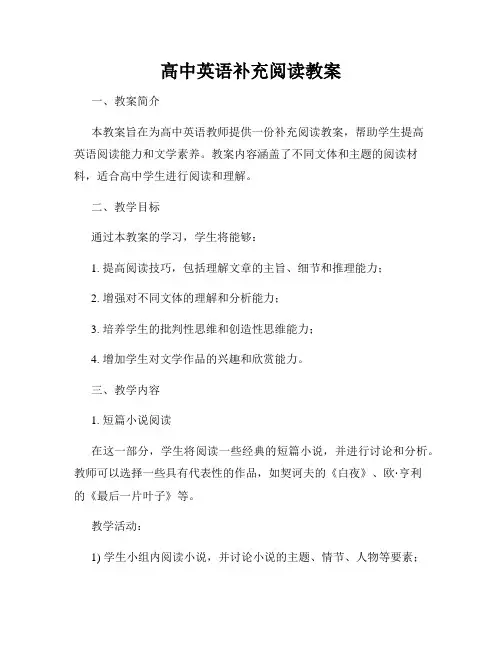
高中英语补充阅读教案一、教案简介本教案旨在为高中英语教师提供一份补充阅读教案,帮助学生提高英语阅读能力和文学素养。
教案内容涵盖了不同文体和主题的阅读材料,适合高中学生进行阅读和理解。
二、教学目标通过本教案的学习,学生将能够:1. 提高阅读技巧,包括理解文章的主旨、细节和推理能力;2. 增强对不同文体的理解和分析能力;3. 培养学生的批判性思维和创造性思维能力;4. 增加学生对文学作品的兴趣和欣赏能力。
三、教学内容1. 短篇小说阅读在这一部分,学生将阅读一些经典的短篇小说,并进行讨论和分析。
教师可以选择一些具有代表性的作品,如契诃夫的《白夜》、欧·亨利的《最后一片叶子》等。
教学活动:1) 学生小组内阅读小说,并讨论小说的主题、情节、人物等要素;2) 学生进行个人或小组演绎,以提高对故事的理解和表达能力;3) 教师引导学生分析文本的语言特点和故事结构。
2. 新闻报道阅读这部分通过阅读新闻报道,使学生了解并关注最新的社会热点和国际动态。
教师可以选择一些有趣且具有教育意义的新闻报道,如科技新闻、社会问题、环保等。
教学活动:1) 请学生在阅读前猜测新闻的主题和内容;2) 学生进行速读,了解大意,并回答相关问题;3) 学生与同伴讨论新闻报道的价值和影响。
3. 文化遗产介绍这部分通过介绍或阅读关于世界各地的文化遗产的文章,增强学生对不同文化的理解和欣赏。
教师可以选择一些世界著名的文化遗产,如埃及金字塔、中国长城等。
教学活动:1) 教师进行文化背景的介绍,并展示相关图片或视频;2) 学生进行阅读,并回答问题,例如这个文化遗产的历史、建筑风格、文化意义等;3) 学生分组进行展示,分享对文化遗产的理解和想法。
1. 创设情境为了激发学生的学习兴趣和积极性,教师可以创设相关的情境,如模拟新闻发布会、组织文学讨论会等,让学生在轻松的氛围中进行学习和交流。
2. 合作学习学生在小组内进行讨论和合作,可以提高学生的语言表达能力和批判性思维能力。
高中英语阅读专项导引教案
1. 教学目标
- 增强学生的英语词汇量和语法知识。
- 提升学生的快速阅读与精读技巧。
- 培养学生的批判性思维和分析能力。
- 引导学生学会总结和归纳文章主旨。
2. 教学内容
- 精选适合高中生阅读水平的英文文章,涵盖不同体裁和主题。
- 设计针对性的阅读问题,考察细节理解、推理判断及词义猜测等技能。
- 提供词汇和短语学习,帮助学生扩充语言资源。
3. 教学方法
- 采用任务驱动式教学法,通过具体任务激发学生学习兴趣。
- 实施分层教学,根据学生实际水平提供个性化指导。
- 结合多媒体工具,如视频、音频材料,增加课堂互动性。
4. 教学过程
- 导入:通过提问或讨论引出话题,激发学生兴趣。
- 新课呈现:教师引导学生阅读新材料,共同探讨文章结构和内容。
- 练习:学生独立或小组合作完成练习题,教师巡回指导。
- 总结:回顾本节课学到的知识点,强化记忆。
- 作业布置:根据课堂表现,分配适量的阅读和习题作业。
5. 评价方式
- 进行定期的阅读测试,检验学生的理解和分析能力。
- 通过课堂表现和作业完成情况,评估学生的学习进度。
- 鼓励学生自我评价,反思学习方法和效果。
6. 教学反思
- 教师需不断更新教学材料,确保内容的时效性和相关性。
- 关注学生的个体差异,调整教学策略以满足不同需求。
- 定期收集学生反馈,优化教学方法和过程。
7. 结语。
高中英语阅读复习课教学设计Final approval draft on November 22, 2020高三英语阅读复习教学设计江西省九江市庐山区一中汪荣明Ⅰ.Teaching Contents 教学内容高三英语阅读复习,通过阅读逆复习基础知识.Ⅳ.Design of Teaching Objectives 教学目标1.Knowledge objectives 知识目标(1)学生能够快速阅读,掌握大意,并能了解细节。
(2)学生通过分析句子,查找词组,积累生词,巩固一轮复习的基础知识。
2.Ability objective能力目标(1)强化略读、查读等阅读技能,训练通过寻找关键词、主题句等方式更快速并准确地确定文章的段落大意,理清文章的总体框架与脉络的技能。
(2)通过分析句子,查找词组,积累生词,巩固一轮复习的基础知识3.Affective objectives 情感价值目标(1)帮助学生理解环保的重要意义(2)在小组合作互动中,增强学生的团队合作精神与分享意识。
Ⅴ.Teaching Important Points(教学重点)1.阅读能力的培养和阅读技巧的训练。
Ⅵ. Teaching Difficult Points(教学难点)a.理解环保的重要意义,从而树立正确的价值观;b.训练用英语获取信息、处理信息、分析问题和解决问题的能力。
Ⅶ. Teaching Methods(教学方法)1. Task-based method to make students interested in what they will learn.(任务型教学法)2. Fast reading to get the general idea of the passage.(略读法)3. Careful reading to get some detailed information.(细读法)Ⅷ. Teaching Aids:(教学手段)多媒体教学Ⅸ. Teaching procedures (教学程序)Step I Fast readingFist get the general idea and find the answers to each questions,please find thesentenses which you find the answers according to.Ask somestudents to give the general ideas and give us the best answers.[设计说明] 本环节主要是快速阅读,按高考要求快速答题。
阅读理解指导课的授课方案授课老师:授课年级:高三年级授课课型:猜想词义指导课授课时长: 40 分钟(一)综合解析1.学生解析学生已经完成广东省高考要求的八个模块的学习,我校学生还学习了模块九,从语言知识的积累方面来看,绝大部分学生完好可以对付高考的阅读任务。
但是,部分学生还没有完全养成优异的英语阅读习惯和掌握做阅读理解题的方法,比方在阅读文章时边阅读边查词典,遇到生词心理害怕,惊慌失措,这些因素都限制着他们对文章的理解以及答题的速度。
鉴于此,教师有必要在课堂上帮助他们掌握常用猜想词义的解题方法,以提高他们的阅读能力。
2.题型解析依照《 2007 年一般高等学校招生全国一致考试(广东卷)英语科考试大纲》对考生阅读能力的要求,考生能读懂书、报、杂志中关于一般性话题的简短文段以及通知、说明、广告等,并能从中获取相关信息。
考生应能:(1)理解主旨和要义;(2)理解文中详尽信息;(3)依照上下文推断生词的词义;(4)作出判断和推理;(5)理解文章的基本结构;(6)理解作者的妄图、见解和态度。
授课老师将在本节课主要指导学生如何在阅读过程中进行词义猜想。
3.资料解析本节指导题课采用的猜想词义训练资料均选自2007 年全国各地高考英语试题中的阅读理解部分。
难度适中,针对性强,拥有很高的训练价值,有助于激励学生学以致用,增强学生的信心,从而达到提高学生的猜想词义能力的收效。
(二)授课目1.感情度目理解是高考英的重,分重,此做得利害将直接影响高考的成,因此,教要培养学生遇不惊、遇易不松的心以及的意志。
极向上的感情、烈的学机有利于学生提高学效率;的意志和的自信心有助于学生战胜外学中遇到的困。
消极的感情如焦、害怕、、怒、沮、疑、等,会影响学潜力的。
若是学者的消极感情影响太大,再好的教、教材、授课方法也无于事。
在理解指中,教要多激励学生,激学生学情,将学生的注意力引到解技巧上来。
本旨在利用高考真帮助学生快速感知技巧,提高其信心和求知欲。
高中英语阅读新概念教案1. 教案目标本教案旨在通过精选的阅读材料,使学生掌握并运用多种阅读策略,如预测、归纳、推理、总结等,同时培养学生对文章结构的敏感性,以及快速获取信息的能力。
通过对文章内容的深入分析,引导学生学会批判性思考,增强语篇理解和分析的能力。
2. 教学内容本节课选取了一篇具有丰富文化背景和深刻主题的英文文章,文章长度适中,难度符合高中学生的阅读水平。
内容涉及当代社会热点问题,能够激发学生的学习兴趣,同时提供了丰富的词汇和句型学习资源。
3. 教学方法- 导入阶段:通过提问和讨论的方式,激活学生的背景知识,为阅读活动做铺垫。
- 阅读阶段:分层次进行,首先是快速阅读以把握大意,然后是细读以理解细节,最后是深度阅读以分析作者观点和写作手法。
- 互动阶段:学生分组讨论文章的主题和结构,分享各自的理解和感悟。
- 总结阶段:教师引导学生总结文章的主要内容和语言特点,巩固词汇和语法知识点。
4. 教学步骤1. 导入话题,激发兴趣。
2. 快速阅读,捕捉主旨。
3. 详细解读,分析段落。
4. 小组讨论,深化理解。
5. 全班分享,扩展视野。
6. 教师点评,提升认知。
7. 布置作业,巩固成果。
5. 教学评价通过课堂表现、小组讨论和个人作业来综合评价学生的学习效果。
重点关注学生是否能够独立运用阅读策略,以及是否能够在阅读后准确表达自己的观点和理解。
6. 教学反思课后,教师需根据学生的反馈和学习成果,对教案进行调整和优化。
这包括调整阅读材料的难度,改进教学方法,或是增加更多互动性和参与性的活动。
高中英语阅读课优秀教案一个优秀的教案应当以学生为中心,注重培养学生主动探索和独立思考的能力。
为此,教学目标应明确具体,既要包括语言知识的掌握,也要涉及阅读技能的提升,如快速获取信息、推理判断、批判性思维等。
同时,教案还应该考虑到不同层次学生的需求,设计分层次的教学活动,让每个学生都能在自己的水平上有所进步。
课堂内容的安排要科学合理。
一方面,教师需要精选适合学生水平的阅读材料,这些材料应覆盖广泛的主题和体裁,以扩大学生的阅读视野。
另一方面,教学内容的组织要由浅入深,循序渐进。
例如,可以从词汇和短语的学习开始,逐步过渡到句子结构、段落大意的理解,最后再到全文的分析和讨论。
在教学方法上,互动式教学是提高课堂效率的有效手段。
教师可以采用小组讨论、角色扮演、辩论赛等形式,鼓励学生积极参与到课堂活动中来。
这样的教学方法不仅能够锻炼学生的口语表达能力,还能增强他们对阅读材料的理解和记忆。
教案中还应包含形式多样的练习题和活动,以巩固学生的学习成果。
这些练习可以是填空题、选择题、简答题等形式,旨在检测学生对阅读材料的理解程度。
同时,教师还可以设计一些创新的活动,如让学生自己编写与阅读材料相关的短文或故事,这样可以进一步激发学生的创造力和想象力。
评价机制也是教案中不可或缺的一环。
教师需要通过定期的测验、作业检查和课堂表现来评估学生的学习进度和效果。
这种评价应该是全面的,不仅仅关注学生的语言知识掌握情况,更要关注他们的阅读技能和策略的运用。
同时,教师还应该给予学生及时有效的反馈,帮助他们认识到自己的不足,并指导他们如何改进。
一个优秀的教案还需要不断地更新和完善。
教师应该根据学生的实际情况和教学反馈,适时调整教案内容和教学方法。
只有这样,教案才能真正适应学生的学习需求,发挥最大的教学效果。
高中英语阅读教学设计教资导言:高中英语阅读教学是教师在教育教学过程中极为重要的一环,对学生的英语水平提升和语言能力培养起到至关重要的作用。
本文将介绍一种高中英语阅读教学设计教资,以帮助教师提升阅读教学效果,开发学生的阅读能力。
一、教学目标阅读教学的目标主要包括:1. 帮助学生掌握基本的阅读技巧,如扫读、略读、详读等;2. 培养学生良好的阅读习惯,提高他们的阅读速度和理解能力;3. 开发学生的批判性思维,培养其分析和推理能力;4. 培养学生的阅读兴趣,激发他们对英语文学及其他领域知识的探索欲望。
二、教学内容高中英语阅读教学内容主要包括以下几方面:1. 阅读理解练习:选择适当的文章和练习题目,以帮助学生提高阅读的速度和准确度。
2. 阅读技巧训练:教授学生如何使用不同的阅读技巧,例如快速定位关键信息、运用上下文推断词义等。
3. 阅读策略指导:教授学生如何制定阅读计划,分析文章结构,有针对性地提高阅读理解能力。
4. 阅读材料选择:选择与学生年龄和学科相关的阅读材料,如文学作品、科普文章、历史故事等。
三、教学方法为了达到上述教学目标,教师可以采用以下教学方法:1. 互动式教学:教师与学生积极互动,通过提问、讨论、角色扮演等活动促进学生的思维发展和交流能力。
2. 小组合作学习:将学生分组,组内合作完成阅读任务,相互讨论和分享观点,提高思维碰撞和合作意识。
3. 案例分析:选择真实的阅读案例进行分析,引导学生运用所学知识解决问题,提高其解决实际问题的能力。
4. 多媒体辅助教学:利用多媒体技术和网络资源,引导学生进行电子图书和网络文章的阅读,扩展学生的阅读广度和深度。
四、教学评价为了评价教学的效果,教师可以采用以下评价方式:1. 课堂测试:设置小测验或作业,考察学生对阅读材料的理解和运用阅读技巧的能力。
2. 作品展示:要求学生用英语写读后感、摘录重点句子、总结文章结构等,展示他们的阅读成果。
3. 互评互鉴:学生进行小组互评,互相提出建议和改进意见,促进学生在阅读过程中的自我反思和学习成长。
2014年高三下英语阅读课复习教案Targets of this lesson:1)Know about the present situation of Chinese education.2) 2)Know some organization of education.3)Learn the problems and achievement of education worldwide now.4) Practise student’s ability of detailed reading.5)Realize the relationship between education and economy.Pre-readingLook around your school and list all the equipment, people and plans that are needed to run a school. In order to run a school, we needA. buildings as classrooms and officesB. a playground for the studentsC. desks and chairsD. TV sets , computers and any other equipmentE. teachers and other workersF. a lot of other thingsLeading in1)Have you ever seen this picture before?This is a picture in a public advertisement to encourage people to help poor children SkimmingChoose the best heading for each paragraph1. Education for all children worldwide will be difficult to achieve2. Solving the problem of teaching quality in remote areas3. Compulsory education for all Chinese children4. Problems of number and location5. Encouraging people in rural areas to accept education6. Meeting the cost7. Education for All --- an international target1-G 2-F 3-A 4-D 5-C 6-E 7-BCareful ReadingChoose the best answer1.______ prevents some people attaching importance to education. A. The importance of agriculture B. Heavy work on the farm C. Traditional ideas D. All the above2. What kind of classes can often be seen in western provinces in China?A. Mixed grade classesB. Classes of large sizesC. Classes of small sizesD. Classes by two-way radio and mail3.What measures do many developing countries take to provide schools with necessary equipment?A. They call on their citizens to donate itB. They depend on aid from other countries and international organizations or programsC. They depend on the local governments .D. Developed provinces provide aid for less developed provinces 4. According to Paragraphf , which of the following is one of the education problems existing in America ?A. The quality of teaching is not good nationwideB. There are too many families now below poverty lineC. One third of the students live in the countrysideD. Violent crimes take place in schoolyards 推理判断:5. which of the following is not true according to the text ?A. It is important to create a positive attitude in agriculture areas, because it is not easy t o change traditional ideas there.B. How people are distributed can affect the education system.C. In the least developed nations of Africa, “ Education for All ” will be a huge task.D. Class sizes are bigger in city schools than in rural ones6.What suggests that many countries realize the importance of education ?A. They realize that the future welfare of their citizens is closely linked to educationB. They attended the World Education Forum in 2000C. At the World Education Forum in 2000, they made a commitment called “Education f or all”D. They are trying to get every child into school主旨大意:7. The text is mainly about _________________.A. the education development in primary schools in China.B. the education development in the world.C. the development in education popularization (普及) in China.D. the development in education popularization in the world. 词义推断:8.The members countries made a commitment to provide “ complete , free and compuls ory primary education of good quality for all children by 2015.The meaning of the word “commitment” is similar toA. agreementB. decisionC. PromiseD. introduction DABC DCAC ListeningListen to the passage . Pay attention to the pronunciation and intonation. At the same ti me ,underline the phrases in the text .1. reach the target2. play an important role3. be closely linked to…4. to begin with5. attach importance to6. be sceptical of7. change traditional ideas 8. have a tendency to9. less developed areas 10. take sb. away from1. reach the target 达到目标2. play an important role 发挥重要作用3. be closely linked to…与密切联系4. to begin with 首先5. attach importance to 重视6. be sceptical of 怀疑7. change traditional ideas 改变传统观念8. have a tendency to 有…倾向9. less developed areas 欠发达地区10. take sb. away from 使…脱离Consolidation :Fill in the following blanks according to the text.In 1986, the Chinese government the law of “nine years of compulsory education” for every Chinese child by the year 2000. The turns out highly successful. Besides China, all the governments in the world realize that the future welfare of the citizens educati on. For the calculated 113 million children not being in school from the World Educatio n Forum, the UNESCO to provide “education for all” by 2015, which has similar diffi culties in different countries.To create is important in carrying out the goal, especially in areas where agriculture and children to be absent and often drop out tohelp work in the fields.China’s large population and big land produce large class sizes and mixed-grade classes. And in Australia where the population is scattered widely the “” methods with the h elp of two-way radio and mail is very useful.Because the success in depends on economy. some poor countries have to aid fro m other countries and internationalorganizations . In fact , every country faces problems in education, which makes the gov ernments look for ways to solve them. The Chinesegovernment has to accomplish the “nine years of ” goal. But things are different in the least developed countries . So the goal “Education for all” will be a huge task for th e world.In 1986, the Chinese government introduced the law of “nine years of compulsory educ ation” for every Chinese child by the year 2000. The outcome turns out highly successfu l. Besides China, all the governments in the world realize that the future welfare of the c itizens is closely linked to education. For the calculated 113 million children not being i n school from the World Education Forum, the UNESCO made a commitment to provid e “education for all” by 2015, which has similar difficulties in different countries.To create a positive attitude is important in carrying out the goal, especially in areas whe re agriculture plays an important role and children have a tendency to be absent and ofte n drop out to help work in the fields.China’s large population and big land produce large class sizes and mixed-grade classes. And in Australia where the population is scattered widely the “distance learning” metho ds with the help of two-way radio and mail is very useful.Because the success in bringing education to all depends on economy. some poor countr ies have to rely on aid from other countries and international organizations. In fact, every country faces problems in education, which makes the governments look for ways to s olve them. The Chinese government has overcome problems to accomplish the “nine ye ars of compulsory education” goal. But things are different in the least developed countr ies .So the goal “Education for all” will be a huge task for the world.DiscussionWhat can we do to help the poor children in less-developed areas in China?Homework1.Read the text again and try to retell the text in your own words.2. Write a short passage:和其他国家一样, 中国政府正在尽其最大的努力给学龄儿童提供九年义务教育. 而且结果非常成功. 然而, 在农村地区,贫困地区,人口稀少地区仍然存在许多问题和困难. 远程教育和混合班很有帮助. 一些国际组织和地方组织都提供了一些钱来满足贫困地区的花费.尽管“全民教育”这个目标很难达到, 联合国教科文组织,每个政府以及一些当地组织正在努力.我们的路很漫长,但我们一定会成功!In China, as in other countries, the government has been doing its best to provide every school-age child nine years of compulsory education and the outcome is highly successf ul. Yet, problems and difficulties remain in the rural areas, some poor countries and less-populated areas. Distance learning and mixed-grade classes helped a lot. Besides, some international organizations and local organizations offered money to meet the cost in the poor areas. Though “Education for All”— the international target is hard to achieve, th e UNESCO, every government and some local organizations are doing their bits. There i s a long way to go, but we’re sure to succeed.。